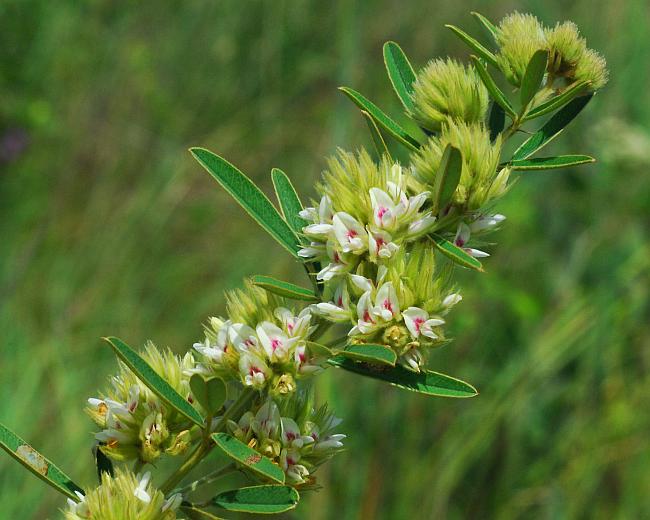Lespedeza capitata Michx.
Round-Headed Bush Clover

Native
CC = 6
CW = 3
MOC = 66
© SRTurner
Lespedeza capitata Michx.Round-Headed Bush Clover | |
 |
Native CC = 6 CW = 3 MOC = 66 |
© SRTurner |
|
Family - Fabaceae/Faboideae Habit - Perennial forb. Stem - Ascending to erect, to 2 m, 3-10 mm in diameter near the base, generally unbranched below the midpoint, densely pubescent with spreading or appressed hairs, often with a silvery or tawny appearance, the hairs not confined to longitudinal ridges, becoming sparsely pubescent or glabrous toward the base.
Leaves - Alternate, petiolate, trifoliate, stipulate. Primary median leaves with the petiole short and stout, 1-6 mm long, 0.7-1.0 mm wide, densely hairy. Stipules 2-6 mm long, linear-triangular to nearly hairlike. Leaflets 20-45 mm long, 6-10 mm wide, the shape variable, elliptic to oblong, rounded at the base, usually rounded at the tip, often with a silvery or tawny sheen, the upper surface silvery-hairy to nearly glabrous, the undersurface moderately to densely appressed-hairy. Axillary leaves rudimentary or absent.
Inflorescences - Primarily from the axils of upper leaves, unbranched clusters or short, dense racemes, generally equaling or shorter than the subtending leaves but sometimes exceeding them. Flowers 16-40 per raceme, the axis usually hidden by the flowers.
Flowers - Calyces 5-lobed, the tube 0.7-1.0 mm long, the lobes 6-13 mm long, minutely hairy, persistent at fruiting. Corollas papilionaceous, 8-10 mm long, cream-colored with purple markings on the banner, the keel nearly equal to or longer than the wings, glabrous. Stamens 10, 9 of the filaments fused and 1 free nearly to the base, the anthers small, attached near the midpoint, all similar in size. Ovary ellipsoid to ovoid, sessile or short-stalked, the style slender, usually glabrous, straight in chasmogamous flowers and recurved in cleistogamous flowers, persistent at fruiting, the stigma small and terminal.
Fruits - Modified legumes, flattened, 4-5 mm long, the calyx longer than the fruit. Seeds 2.5-3.0 mm long, olive green to brown or nearly black. Flowering - July - October. Habitat - Prairies, glades, savannas, forest openings, old fields, open disturbed areas. Origin - Native to the U.S. Lookalikes - Broadly, L. hirta. Other info. - This tall bush clover is reasonably common across Missouri and the eastern half of the continental U.S., and it also ranges into Canada. It is most often found in high quality habitats. It is also a frequent component of seed mixes for prairie restorations, and also for rangelands, as the plants are palatable and highly nutritious to livestock. Like other legumes, it fixes nitrogen from the atmosphere and enriches the soil. The plant serves as a host for numerous butterfly species, and its seeds are relished by birds such as bobwhite quail. Photographs taken at Fort Benning, GA., 10-10-05 (DETenaglia); also at Shaw Nature Reserve, Franklin County, MO, 8-26-2006 and 8-3-2007, and Tucker Prairie Natural Area, Callaway County, MO, 8-21-2015 (SRTurner). |